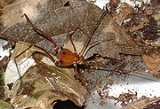
Gonyleptidae
Encyclopedia
Gonyleptidae is a Neotropical family of harvestmen (Order Opiliones) with more than 800 species, the largest in the Suborder Laniatores
and the second largest of the Opiiones as a whole. The largest known harvestmen are gonyleptids.
Like most harvestmen, gonyleptids are almost exclusively nocturnal, except some Caelopyginae, Goniosomatinae, (during reproductive season), Gonyleptinae, Mitobatinae, Pachylinae and Progonyleptoidellinae. Most species inhabit dense tropical, subtropical and temperate (Chile) forests, but some occur in open vegetation as the Pampas, the Cerrado
, and the Caatinga
. There are some species that live in caves, but only three troglobite
s are recorded for the family.
. Pedipalpus with cylindrical segments, strongly spined, tibia and tarsus flattened ventrally. Basal segments of leg IV with strong sexual dimorphism, shown either in spination, curvature or length. Penis with ventral plate well defined, glans may bear ventral and/or dorsal processes.
n continent (Southern Chile
and Argentina), Falklands to Costa Rica
, with one isolated species cited from Guatemala
.
and both are related to the Stygnidae
and Cranaidae
(Kury, 1992).
Laniatores
Laniatores is the largest suborder of the arachnid order Opiliones with over 4,000 described species worldwide. The majority of the species are highly dependent on humid environments and usually correlated with tropical and temperate forest habitats....
and the second largest of the Opiiones as a whole. The largest known harvestmen are gonyleptids.
Like most harvestmen, gonyleptids are almost exclusively nocturnal, except some Caelopyginae, Goniosomatinae, (during reproductive season), Gonyleptinae, Mitobatinae, Pachylinae and Progonyleptoidellinae. Most species inhabit dense tropical, subtropical and temperate (Chile) forests, but some occur in open vegetation as the Pampas, the Cerrado
Cerrado
The Cerrado, is a vast tropical savanna ecoregion of Brazil, particularly in the states of Gioas and Minas Gerais...
, and the Caatinga
Caatinga
Caatinga is a type of vegetation, and an ecoregion characterized by this vegetation in the northeastern part of Brazil. The name "Caatinga" is a Tupi word meaning "white forest" or "white vegetation"...
. There are some species that live in caves, but only three troglobite
Troglobite
Troglobites are small cave-dwelling animals that have adapted to their dark surroundings. Troglobite species include spiders, insects, fish and others. They live permanently underground and cannot survive outside the cave environment. Troglobite adaptations and characteristics include a heightened...
s are recorded for the family.
Name
The family is named after the type genus Gonyleptes, which is derived from Greek gony, gonatos = joint, knee + leptos, ê, on = thin, fine, delicate.Diagnosis
Laniatores with coxa IV immensely developed, widely surpassing dorsal scutum in dorsal view in most species. Many species with double ozoporeOzopore
An ozopore is a defensive gland present in harvestmen, which are eight-legged arachnids also known as "daddy long-legs". These glands, also called "scent glands", "repugnatorial glands", "odoriferous glands" or "stink glands" by various authors, are located at the anterior sides of the prosoma.The...
. Pedipalpus with cylindrical segments, strongly spined, tibia and tarsus flattened ventrally. Basal segments of leg IV with strong sexual dimorphism, shown either in spination, curvature or length. Penis with ventral plate well defined, glans may bear ventral and/or dorsal processes.
Distribution
Recorded continuously from the southernmost tip of the South AmericaSouth America
South America is a continent situated in the Western Hemisphere, mostly in the Southern Hemisphere, with a relatively small portion in the Northern Hemisphere. The continent is also considered a subcontinent of the Americas. It is bordered on the west by the Pacific Ocean and on the north and east...
n continent (Southern Chile
Chile
Chile ,officially the Republic of Chile , is a country in South America occupying a long, narrow coastal strip between the Andes mountains to the east and the Pacific Ocean to the west. It borders Peru to the north, Bolivia to the northeast, Argentina to the east, and the Drake Passage in the far...
and Argentina), Falklands to Costa Rica
Costa Rica
Costa Rica , officially the Republic of Costa Rica is a multilingual, multiethnic and multicultural country in Central America, bordered by Nicaragua to the north, Panama to the southeast, the Pacific Ocean to the west and the Caribbean Sea to the east....
, with one isolated species cited from Guatemala
Guatemala
Guatemala is a country in Central America bordered by Mexico to the north and west, the Pacific Ocean to the southwest, Belize to the northeast, the Caribbean to the east, and Honduras and El Salvador to the southeast...
.
Subfamilies
At the moment, Gonyleptidae comprises 16 subfamilies, 284 genera and 823 species:- Ampycinae (2 genera; 3 species)
- Bourguyiinae (8; 15)
- Caelopyginae (9; 29)
- Cobaniinae (1; 2)
- Goniosomatinae (5; 46)
- Gonyassamiinae (2; 3)
- Gonyleptinae (38; 142)
- Hernandariinae (4; 12)
- Heteropachylinae (8; 11)
- Metasarcinae (13; 25)
- Mitobatinae (1; 45)
- PachylinaePachylinaePachylinae Sørensen, 1884 is the most diverse subfamily of the harvestman family Gonyleptidae, including around 400 valid species . Major groups of species occur in the Brazilian Atlantic Forest, Bolivian/Peruvian Highlands, Argentina and Chilean Temperate Forest.- Important genera :Currently, 128...
(129; 400) - Pachylospeleinae (1; 1)
- Progonyleptoidellinae (10; 17)
- Sodreaninae (4; 5)
- Tricommatinae (29; 51)
Relationships
Gonyleptidae is the sister-group of CosmetidaeCosmetidae
Cosmetidae, with around 700 species, is the second most diverse family of the Suborder Laniatores. They are distributed from Argentina to southern USA, most diverse in northern South America, Central America and Mexico...
and both are related to the Stygnidae
Stygnidae
The Stygnidae are a family of neotropical harvestmen within the suborder Laniatores.-Description:Body length ranges from about one to six millimeters. The color ranges from light brown to reddish...
and Cranaidae
Cranaidae
The Cranaidae are a family of neotropical harvestmen within the suborder Laniatores.-Name:The name of the type genus is derived from Cranaus, the successor of Cecrops I as king of Attica in Greek mythology.-Description:...
(Kury, 1992).

